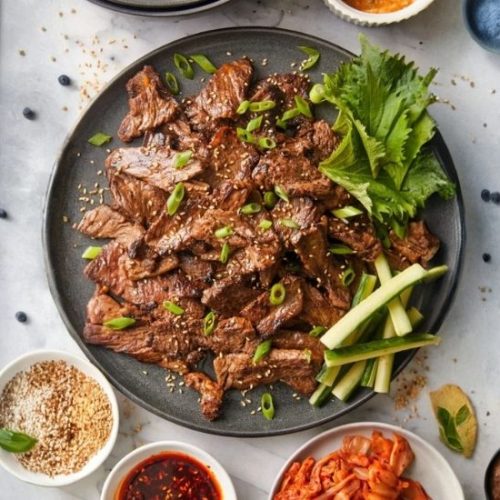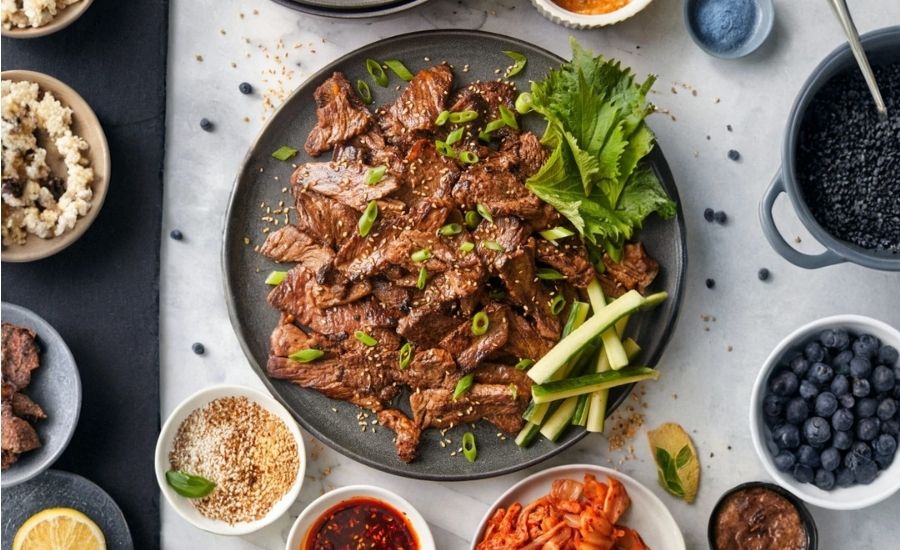All products are selected by our editorial team for quality. If you buy through our links, we may earn a small commission at no extra cost to you.
This Korean Beef Bulgogi recipe is a delightful fusion of bold flavors and tender, juicy meat that captures the essence of traditional Korean cooking.
What makes this dish truly special is the pear-infused marinade, which naturally tenderizes the rib eye while adding a subtle sweetness that perfectly balances the savory soy sauce, spicy gochujang, and aromatic garlic and ginger.
Rich in protein from the quality rib eye steak, it offers a satisfying, muscle-nourishing meal that also includes healthy fats from toasted sesame oil.
Despite the indulgence, this recipe remains relatively low in saturated fat, thanks to lean slicing and the grilling method.
Its quick 15-minute cook time after marinating makes it an excellent choice for meal prep or a fast weeknight dinner, while the flavors develop beautifully with the 2-hour marinating period.
Easy to make and incredibly flavorful, it’s a recipe that can transform everyday cooking into a special occasion.
Must-Have Tools for Perfect Results
Cast Iron Grill Pan
Essential for achieving those signature charred grill marks and caramelization on the beef slices, this pan delivers even heat retention and superior searing.
Beyond this recipe, it’s perfect for grilling indoors year-round, from steaks to vegetables.
Sharp Chef’s Knife
For slicing the partially frozen steak thinly and uniformly, a sharp chef’s knife ensures precision and safety.
A good knife also streamlines prep work across all your kitchen tasks.
Mixing Bowl
A medium mixing bowl is crucial for blending the marinade ingredients thoroughly, allowing the flavors to meld perfectly.
Durable, easy-to-clean bowls are indispensable for every cook.
Gallon-Size Ziploc Bag
Perfect for marinating the beef evenly and mess-free, these bags make turning and storing ingredients effortless. Reusable silicone bags are an eco-friendly alternative that also works great.
Microplane Grater
Ideal for finely grating the pear and fresh ginger, a microplane ensures a smooth texture that blends seamlessly into the marinade. This tool is a kitchen must-have for zesting, grating, and adding fresh aromatics.

Authentic Korean Beef Bulgogi
Equipment
- 1 Cast Iron Grill Pan
- 1 medium mixing bowl
- 1 Sharp Chef’s Knife
- 1 Gallon-Size Ziploc Bag
- 1 Microplane Grater
Ingredients
- 1½ pounds boneless ribeye steak
- ½ small ripe pear peeled and finely grated
- ¼ cup low-sodium soy sauce
- 2 tablespoons packed brown sugar
- 2 tablespoons toasted sesame oil
- 3 cloves garlic minced
- 1 tablespoon freshly grated ginger
- 1 tablespoon gochujang Korean red chili paste
- 2 tablespoons vegetable oil divided
- 2 green onions thinly sliced (for garnish)
- 1 teaspoon toasted sesame seeds for garnish
Instructions
- Prepare the Steak for Slicing: Wrap the ribeye steak tightly in plastic wrap and place it in the freezer for about 30 minutes. This firms up the meat, making it easier to slice into thin, even strips.
- Slice the Steak Thinly: Remove the steak from the freezer and unwrap it. Using a sharp knife, slice the meat against the grain into ¼-inch thick slices. Cutting against the grain ensures tenderness.
- Create the Marinade: In a medium mixing bowl, combine the grated pear, soy sauce, brown sugar, sesame oil, minced garlic, grated ginger, and gochujang. Whisk until well blended and smooth.
- Marinate the Beef: Place the sliced beef into a gallon-sized resealable bag or a shallow container. Pour the marinade over the meat, seal tightly, and massage the bag gently to coat all the slices. Let the beef marinate in the refrigerator for a minimum of 2 hours or ideally overnight, flipping the bag occasionally for even soaking.
- Grill the Bulgogi: Heat 1 tablespoon of vegetable oil in a cast iron grill pan over medium-high heat. Once hot, place the marinated beef slices in a single layer in the pan. Avoid overcrowding—cook in batches if needed. Sear each side for 2–3 minutes until lightly charred and fully cooked. Repeat with the remaining oil and meat.
- Garnish and Serve: Transfer the cooked beef to a serving platter. Sprinkle with sliced green onions and toasted sesame seeds for a final touch of flavor and presentation. Serve hot with rice, lettuce wraps, or your favorite Korean sides.
Notes
- Freezing Tip: Don’t skip the partial freezing step—it’s key to getting thin, restaurant-style slices without shredding the beef.
- Pear Substitute: If you can’t find Asian pear, a sweet red apple or a bit of pineapple juice can be used to help tenderize and sweeten the marinade.
- Spice Level: Gochujang adds mild to moderate heat. For a spicier kick, add a teaspoon of Korean red pepper flakes (gochugaru).
- Cooking Alternative: If you don’t have a grill pan, a large skillet or cast iron skillet will also work beautifully.
- Meal Prep Friendly: The marinated beef can be portioned and frozen for later use—just thaw and cook as needed for quick weeknight meals.
Chef’s Secrets for Authentic Flavor
The secret to exceptional Korean Beef Bulgogi lies in the marinade and the cut of meat.
Using ribeye is ideal because of its natural marbling, which helps the beef stay tender and juicy during high-heat grilling.
A lesser-known trick is partially freezing the steak before slicing—it firms up the meat and allows you to achieve ultra-thin, even cuts that soak up more flavor.
Grating fresh pear into the marinade adds not only subtle sweetness but also natural enzymes that tenderize the beef.
Be sure to marinate for at least two hours, though overnight yields the most flavorful result.
When cooking, resist the urge to overcrowd the pan.
A sizzling hot surface and enough space around each slice ensure proper caramelization and prevent steaming.
Lastly, always cook in batches and serve immediately for the best taste and texture.
How to Serve It Best
Korean Beef Bulgogi is incredibly versatile and shines in many serving styles.
For a classic approach, serve it over steamed white rice or sticky short-grain rice, garnished with green onions and sesame seeds.
For a low-carb or gluten-free option, wrap the grilled beef in crisp lettuce leaves and top with kimchi or sliced cucumbers.
Bulgogi also works wonderfully as a filling for rice bowls, tacos, or even sandwiches for a Korean-fusion twist.
Pair it with traditional banchan (Korean side dishes) like pickled radish, bean sprouts, or japchae (glass noodles) to complete the meal.
A drizzle of extra gochujang or a side of ssamjang can add even more depth of flavor.
Whether you’re feeding a crowd or prepping meals ahead, bulgogi is easy to pair and sure to impress.
Best Storage Tips and Tricks
If you’re lucky enough to have leftovers, Korean Beef Bulgogi stores beautifully.
Once cooled, transfer any leftover beef into an airtight container and refrigerate for up to 4 days.
Reheat in a skillet over medium heat with a splash of water or broth to revive its juiciness.
For longer storage, you can freeze both the raw, marinated beef and cooked bulgogi.
Place raw marinated slices in freezer-safe bags and freeze flat; they’ll keep well for up to 2 months and can be thawed overnight in the fridge before cooking.
Cooked bulgogi can also be frozen in portions, making it easy to reheat for a quick weeknight dinner.
Avoid microwaving, which can dry out the meat—stovetop reheating preserves the best flavor and texture.
Frequently Asked Questions (FAQs)
1. Can I use a different cut of beef?
Yes! While ribeye is ideal for its tenderness and flavor, you can also use sirloin, flank steak, or even tenderloin. Just make sure to slice it very thin against the grain to keep the meat tender.
2. What if I don’t have gochujang?
Gochujang adds both heat and umami, but if unavailable, you can substitute with a mix of red chili flakes and a touch of miso or soy sauce. The flavor won’t be identical, but it’ll still be delicious.
3. Is this dish spicy?
Mild to medium. Gochujang provides a gentle heat, but it’s balanced by the sweetness from pear and brown sugar. You can adjust the spice level by adding more or less gochujang or including gochugaru (Korean red chili flakes).
4. Can I make this ahead of time?
Absolutely. You can marinate the beef up to 24 hours in advance or freeze the marinated beef for future meals. It’s a great meal prep option that cooks in minutes when ready.
5. Is there a vegetarian version of bulgogi?
Yes! You can substitute thinly sliced mushrooms (like portobello or king oyster) or tofu for the beef. Use the same marinade, adjusting the marinating time to about 30 minutes for vegetables or tofu.
This recipe is inspired by damndelicious and has been carefully refined to enhance clarity, streamline preparation steps, and ensure accurate results. We’ve also included health benefits, nutritional highlights, and Must-Have Tools to help you get the best results every time you cook.


